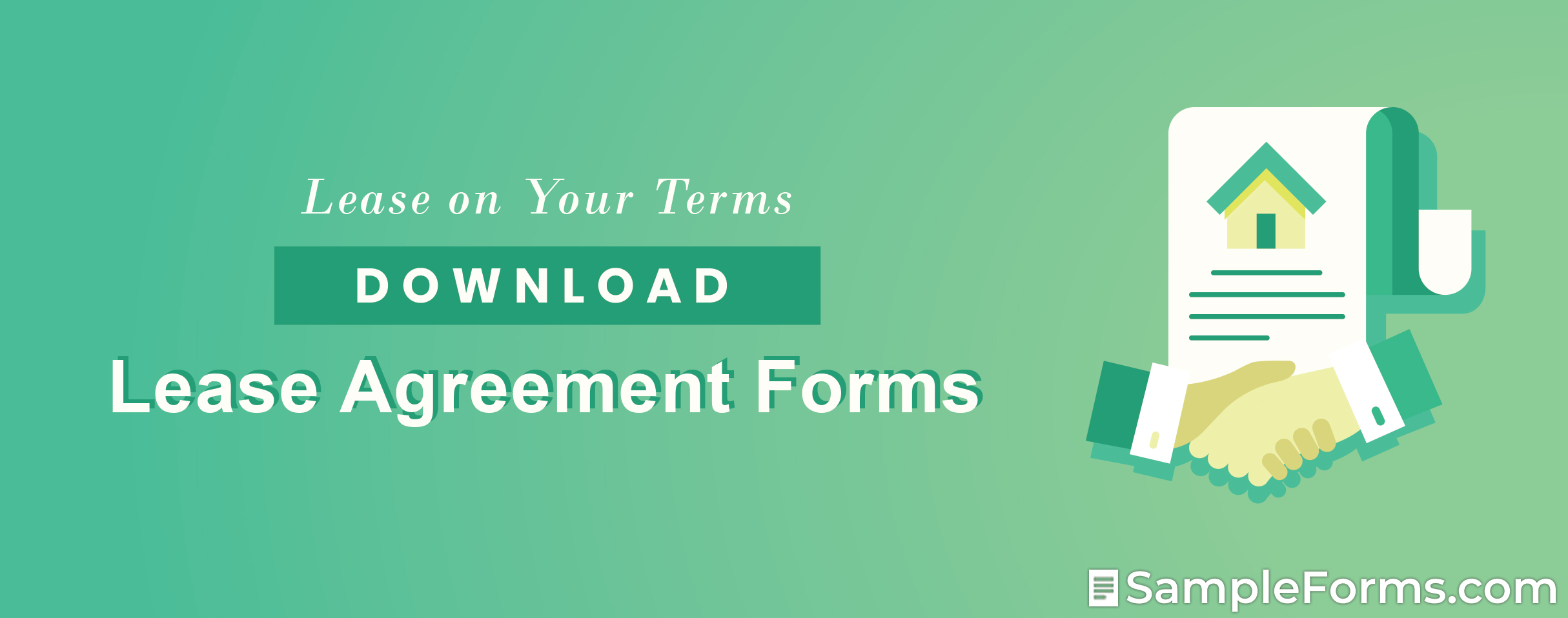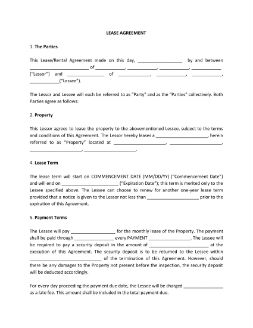- Eviction Notice Forms
- Power of Attorney Forms Forms
- Bill of Sale (Purchase Agreement) Forms
- Lease Agreement Forms
- Rental Application Forms
- Living Will Forms Forms
- Recommendation Letters Forms
- Resignation Letters Forms
- Release of Liability Agreement Forms
- Promissory Note Forms
- LLC Operating Agreement Forms
- Deed of Sale Forms
- Consent Form Forms
- Support Affidavit Forms
- Paternity Affidavit Forms
- Marital Affidavit Forms
- Financial Affidavit Forms
- Residential Affidavit Forms
- Affidavit of Identity Forms
- Affidavit of Title Forms
- Employment Affidavit Forms
- Affidavit of Loss Forms
- Gift Affidavit Forms
- Small Estate Affidavit Forms
- Service Affidavit Forms
- Heirship Affidavit Forms
- Survivorship Affidavit Forms
- Desistance Affidavit Forms
- Discrepancy Affidavit Forms
- Guardianship Affidavit Forms
- Undertaking Affidavit Forms
- General Affidavit Forms
- Affidavit of Death Forms
Lease Agreement
Moving to a new location or traveling to another city means staying there for a few weeks, months, or years. Instead of lodging in hotels, individuals can choose to rent rooms or apartments. Not only is it cost-friendly, but it’s also an excellent way to establish relationships among other people. If you’re a homeowner or building administrator looking for tenants, then you’ll need a tool to seal the deal. Learn the basics of lease agreements and make your document now! Read More

By Type
- Generic Basic Lease Form
- Lease Renewal Agreement
- Roommate/Room Lease Agreement
- Shop/Store Lease Agreement
- Weekly Lease Agreement
- House Lease Agreement
- Horse/Equine Lease Agreement
- RV Lease Agreement
- Notice to Vacate
- Tractor Lease Agreement
- As-Is Vehicle Lease Agreement Form
- Standard Rental Lease Agreement
- Sub Lease Agreement
- Lease Extension Form
- Vacation Home Lease Agreement
- Basement Lease Agreement
- Month-to-Month Lease Agreement
- Room Rental/Lease Agreement
- Standard Rental Lease Form
- Residential Lease Agreement
- Apartment Lease Agreement
Moving to a new location or traveling to another city means staying there for a few weeks, months, or years. Instead of lodging in hotels, individuals can choose to rent rooms or apartments. Not only is it cost-friendly, but it’s also an excellent way to establish relationships among other people. If you’re a homeowner or building administrator looking for tenants, then you’ll need a tool to seal the deal. Learn the basics of lease agreements and make your document now!
What Is a Lease Agreement?
A lease agreement is a legal document that outlines the obligations and conditions between property owners and lessors. As a contractual and binding agreement, each party has a responsibility to uphold and follow. Moreover, leases are not limited to residential and commercial spaces only. Sometimes, it can also be for vehicles, establishments, lands, and equipment. The process of lease agreements includes the duration, payment, and restrictions of the arrangement.
How Do You Write a Lease Agreement?
Lease agreements—as a written record or evidence of a deal—are necessary when it comes to establishing the grounds and limits of an arrangement. With this document, the lender (owner, landlord, or proprietor) can layout the duration of the agreement. Hence, avoiding disputes and misunderstandings from the part of the lessor. Most importantly, assets will get protection from future dilemmas. However, the creation of rental lease agreements can be tricky, especially with the predetermined rules and conditions of the owner. Each lease agreement has different specifications to meet the needs of every tenant. Despite that, the process is doable. So, here are the steps in making a lease agreement.
1. Provide the Description of the Rented Area
When making a lease agreement, the homeowner or landlord has to establish a general view of the property. This portion includes the number of rooms (if renting a house), the neighborhood, the pieces of furniture and appliances that come with the place, and the room number. By providing details about the area of rent, the landlord can reassure future tenants about their living conditions when they choose the property.
2. Elaborate the List of Amenities
Next, the owner should give specifics on the facilities and services the tenant will enjoy while staying in the property. For instance, the renter receives free pizza from the owner every month, or the property has an attached parking space for the resident. Moreover, this section can also contain plans for utilities.
3. Set the Duration of the Lease and Payment Schedule
The timeframe of the lease depends on the needs of the tenant. For traveling entrepreneurs, contracts can be three to six months. In some cases, foreign or local students renting a dorm or room can stay for more than one year. The future occupant and the homeowner have to set the contract to the convenience of everyone in a room/roommate rental arrangement. Additionally, the payment schedule should also be mentioned here. The renter can either use bank deposits or cash to pay the rent.
4. Discuss Conditions, Rules, and Penalties
An essential element of the lease agreement is the guidelines and conditions set by the landlord. Some examples are regulations on waste segregation, acceptance of pets, curfew, vehicle spaces, and usage of utilities. Furthermore, most landlords create a plan that addresses these kinds of issues. In this section of the agreement, the owner and tenant will discuss the repercussions of early termination of the deal.
5. Include General Provisions
And lastly, the last part will be the general provisions. Written in this portion of the document are the waivers, sublease arrangements, personal and external liabilities, rules on changing parts of rooms, and other necessary plans. Most general provisions depend on the preferences of the owner.
Frequently Asked Questions (FAQs)
What if my landlord includes provisions prohibited by the law?
If you encounter agreements with ambiguous clauses and unfair provisions, do contact a lawyer for clarification. Try consulting the landlord or the owner of the rental place to understand the purpose of the misleading sections. Most importantly, check the agreement’s content and the arrangements before signing the document.
Are security deposits necessary when renting a room or apartment?
Although not required by law, security deposits act as a form of protection for homeowners or landlords. The tenant hands the security deposit—roughly a large amount of money—together with the first month’s rent to the landlord. As a one-time scheme, the security deposit protects the landlord from possible damages the tenants may cause. It can also cover losses in furniture and non-payment of rent.
Can I leave my rented apartment before the lease ends?
Yes, some people opt to move out of their rented places before the end of the lease period. However, doing this comes with consequences. For one, you have to continue paying the rental fees for the remaining months. If you run away from the responsibility, the homeowner can charge you with a breach of contract. Therefore, consider these things before breaking the agreement.
Can I bring my pet to the home I will be renting?
Some rental apartments and homes permit pets on the premises, and others are strict when it comes to furry friends. With that, always check the rules of the rental homes or apartments before signing any contract or agreement. If you have pets, look for homes that accept animals in the rooms and surrounding areas.
When looking for another home to buy or rent, we want to have assurance and safety. More than ever, we aim for places that provide efficient services and security. The priority of tenants varies from their current needs. With that, they want to have enough information about the arrangements in writing and not only through verbal agreements. Lease agreements assure both parties that each one will do their obligations in the business transaction. In conclusion, this document is a valuable tool for anyone going through various leasing plans and projects.

